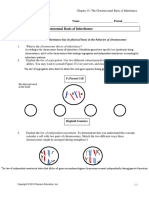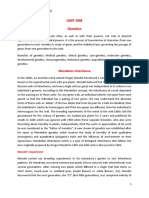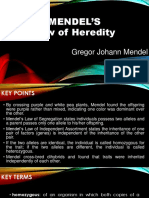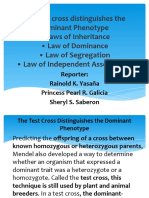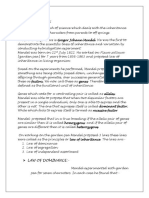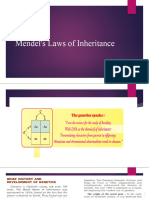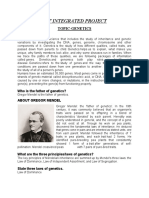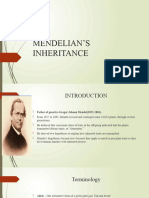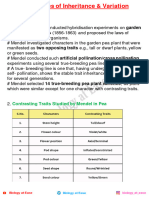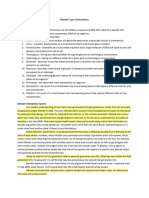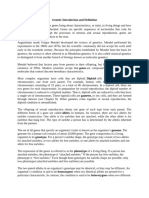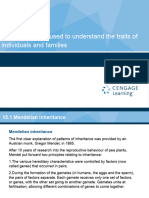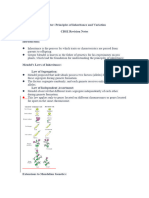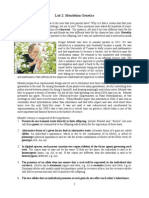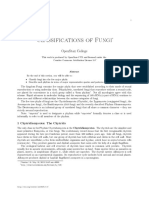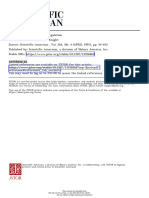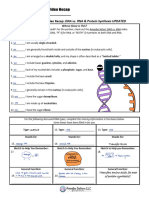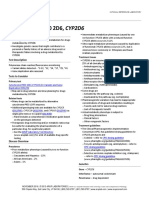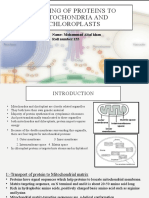AP Bio Ch. 14 To 15 Essay #1
AP Bio Ch. 14 To 15 Essay #1
Uploaded by
Judith HanCopyright:
Available Formats
AP Bio Ch. 14 To 15 Essay #1
AP Bio Ch. 14 To 15 Essay #1
Uploaded by
Judith HanOriginal Title
Copyright
Available Formats
Share this document
Did you find this document useful?
Is this content inappropriate?
Copyright:
Available Formats
AP Bio Ch. 14 To 15 Essay #1
AP Bio Ch. 14 To 15 Essay #1
Uploaded by
Judith HanCopyright:
Available Formats
Judith Han AP Bio Ch.
14-15 Essay #1
Mendel reached several conclusions through his work on the inheritance of characteristics on peas. He discovered that the inheritance of traits is determined by units that are passed on to descendants and these units are now called genes. He also found that each individual inherits an allele from each parent for each trait. When Mendel crossed a purple flower pea plant and a white flower pea plant, he saw that the F1 generation produced all purple flower plants. When two of these F1 plants were crossed, the white flower color appeared again in the F2 generation. Mendel concluded that a trait may not show up in an individual but it can still be passed on to the next generation. From Mendels conclusions come two laws. These laws are the law of segregation and the law of independent assortment. The law of segregation states that for any particular trait, the pair of alleles of each parent separate and only one allele is passed down from each parent on to the offspring. The law of independent assortment states that different pairs of alleles are passed on to the offspring independently of each other. This allows there to be new combinations of genes in the offspring that are not seen in the parents. Although Mendel made opened the way to modern genetics, there were exceptions that deviate from his conclusions that he did not know of. Autosomal linkage is one of these exceptions. Autosomal linkage refers to when genes are located on the same chromosome and therefore they usually show up together in the offspring. However during meiosis, recombination occurs and this can split up the two alleles inherited from each parent and which results in recombinant types. The closer the genes are on the chromosome, the fewer amount of recombinants there will be in the offspring and the other way around. This is because recombination is less likely to split up the two genes if there isnt much space between the genes for there to split. Sex-linked or X-linked inheritance is another exception to Mendels conclusion. Sex-linked inheritance because genes that can be found on the X chromosome.
Judith Han AP Bio Ch. 14-15 Essay #1
Males have a Y chromosome without the same genetic information as an X chromosome. The male offspring will express the trait of whichever allele he receives from his mothers X chromosome. This can be a disadvantage in situations like colorblindness. If a mother is heterozygous for being colorblind and she has children with a normal vision man, her female children will all have normal vision because they receive alleles from their mother and fathers X chromosomes. However, half of her male children will be colorblind because they will receive a colorblind allele from the mother. Polygenic inheritance also deviates from Mendels conclusions because it is the concept that some genes can be inherited together which goes against the law of independent assortment. An example of this is human skin color. There are people who can inherit dominant and recessive genes controlling skin color. This explains why there are people who have skin color ranging from extremely dark to completely white.
You might also like
- Chapter 15 Chromosomal Basis of InheritanceDocument7 pagesChapter 15 Chromosomal Basis of InheritanceJUNG LEE100% (1)
- ANSWERS Worksheets Cell Structure FunctionsDocument24 pagesANSWERS Worksheets Cell Structure FunctionsAnghel LopezNo ratings yet
- NPB 107 SyllabusDocument2 pagesNPB 107 SyllabusApril MartínezNo ratings yet
- Bio Unit-3Document18 pagesBio Unit-3jitendersharmateharkiNo ratings yet
- Applied Genetics Lect 1Document20 pagesApplied Genetics Lect 1gzp6bx7z6vNo ratings yet
- Unit One Genetics: Mendelian InheritanceDocument41 pagesUnit One Genetics: Mendelian Inheritancedambar khatriNo ratings yet
- Mendelian DisordersDocument5 pagesMendelian DisorderskanagadurgaNo ratings yet
- Principles of Inheritance and GeniticsDocument19 pagesPrinciples of Inheritance and GeniticsVaishakhi MuraliNo ratings yet
- Mendelian Concept of HeredityDocument15 pagesMendelian Concept of HereditySHEENA MAE DALGUNTASNo ratings yet
- S 2 (Main)Document12 pagesS 2 (Main)Feary ProcoratoNo ratings yet
- Incomplete DominanceDocument31 pagesIncomplete Dominanceregine13 ikiNo ratings yet
- self notesDocument12 pagesself notestungashindjombaNo ratings yet
- Mendel's Law of HeredityDocument23 pagesMendel's Law of HeredityLaurence CarelNo ratings yet
- Laws of Inheritance, Segregation, Assortment.Document14 pagesLaws of Inheritance, Segregation, Assortment.Hannah Charis L. BarabatNo ratings yet
- Pedigree AnalysisDocument37 pagesPedigree Analysisshelren onlagadaNo ratings yet
- Men DelDocument3 pagesMen DelDorairaj KesavarajNo ratings yet
- Unit 7 HeredityDocument20 pagesUnit 7 HeredityAmriani AnrahNo ratings yet
- GOOD - GeneticsandHeredityDocument78 pagesGOOD - GeneticsandHereditysupanut suponkositNo ratings yet
- Hybrids: Mendel's GeneticsDocument5 pagesHybrids: Mendel's GeneticsAnonymous doCtd0IJDNNo ratings yet
- CH 14 Mendel and The Gene IdeaDocument6 pagesCH 14 Mendel and The Gene Ideawil7ver100% (2)
- Pedigree AnalysisDocument16 pagesPedigree Analysislingeshwaran kalaiselvanNo ratings yet
- Mendel's Laws of InheritanceDocument22 pagesMendel's Laws of Inheritancemalaikazahid99No ratings yet
- Module 4 CytogeneticsDocument21 pagesModule 4 CytogeneticsFrances Riane SimoyNo ratings yet
- Module - Lesson 6Document13 pagesModule - Lesson 6maria elaine melo colesioNo ratings yet
- Art Integrated Project: Topic-GeneticsDocument2 pagesArt Integrated Project: Topic-GeneticsShifa SiddiquiNo ratings yet
- Karl Vincent D. Flores Science ProjectDocument22 pagesKarl Vincent D. Flores Science ProjectGirlie Mae FloresNo ratings yet
- Heredity Line by LineDocument48 pagesHeredity Line by LineamaanmirzarollnoNo ratings yet
- HEREDITY AND EVOLUTION 2-1Document18 pagesHEREDITY AND EVOLUTION 2-1luckyemmanuel765No ratings yet
- AP Bio - Unit 5 BreakdownDocument2 pagesAP Bio - Unit 5 BreakdownAichaNo ratings yet
- Class 12 Biology Chapter 5 Revision NotesDocument9 pagesClass 12 Biology Chapter 5 Revision NotesAnkur YadavNo ratings yet
- Basic Principles of GeneticsDocument3 pagesBasic Principles of GeneticsKuoRosalineNo ratings yet
- Gregor MendelDocument1 pageGregor Mendel20I1190 G-7CNo ratings yet
- 9 InheritanceDocument6 pages9 InheritanceTalita KumalaNo ratings yet
- Bio Class 12Document20 pagesBio Class 12Akanksha TiwariNo ratings yet
- Adobe Scan 11 Jul 2024Document13 pagesAdobe Scan 11 Jul 2024sundaramsharmaj7No ratings yet
- Lecture 3Document29 pagesLecture 3Bilal ImranNo ratings yet
- CBSE Class 10 Science Notes Chapter 9 Heredity and EvolutionDocument18 pagesCBSE Class 10 Science Notes Chapter 9 Heredity and EvolutionHarsh AgarwalNo ratings yet
- Law Independent AssortmentDocument7 pagesLaw Independent AssortmentAllen Nanqui DadizonNo ratings yet
- GeneticsDocument14 pagesGeneticsPRIYA PRIYANo ratings yet
- Chapter 14 Notes 2014Document15 pagesChapter 14 Notes 2014Adeela AashiNo ratings yet
- Principles of Inheritance & Variation NOTESDocument12 pagesPrinciples of Inheritance & Variation NOTESbdjdhdjshsjjNo ratings yet
- Mendels-Law-of-Inheritance (1)Document4 pagesMendels-Law-of-Inheritance (1)Kriss ReissNo ratings yet
- Grade 10 Biology - Notes - CH 9-HeridityDocument6 pagesGrade 10 Biology - Notes - CH 9-HeridityitsmeadiparasharNo ratings yet
- Biology ProjectDocument11 pagesBiology ProjectAgnivo SahaNo ratings yet
- BIO301 Handouts 1 167Document351 pagesBIO301 Handouts 1 167Tayyaba ArbabNo ratings yet
- Lecture 9-14Document5 pagesLecture 9-14aq331560No ratings yet
- Chapter 15Document39 pagesChapter 15Ralph Rezin MooreNo ratings yet
- Ncert Class 12 Biology Chapter 4 Revision NotesDocument2 pagesNcert Class 12 Biology Chapter 4 Revision Notesak9268509No ratings yet
- Biology ProjectDocument22 pagesBiology Projectshruti verma100% (3)
- Law of SegregationDocument14 pagesLaw of SegregationAllen Nanqui DadizonNo ratings yet
- All Goods in The Hood 1Document17 pagesAll Goods in The Hood 1Rj EstabilloNo ratings yet
- Genetics Part 1 and 2Document32 pagesGenetics Part 1 and 2smohammedadenNo ratings yet
- Non Mendelian GeneticsDocument18 pagesNon Mendelian GeneticsMaze twoNo ratings yet
- Genetics-Some-Basic-Fundamentals-1Document6 pagesGenetics-Some-Basic-Fundamentals-1Kamaljeet DhaliwalNo ratings yet
- Gene Alleles Heterozygous: A Codes For Red Color, and Allele A Codes For Yellow Color. Allele Will Produce ADocument3 pagesGene Alleles Heterozygous: A Codes For Red Color, and Allele A Codes For Yellow Color. Allele Will Produce Aregine13 ikiNo ratings yet
- Lab 02 - Mendelian GeneticsDocument13 pagesLab 02 - Mendelian Genetics13ucciNo ratings yet
- Biology Project Pedigree Analysis Class 12Document21 pagesBiology Project Pedigree Analysis Class 12Anonymous DWvfJuMcQNo ratings yet
- 9 InheritanceDocument6 pages9 InheritancePeter TingNo ratings yet
- Mendel Gene Idea: and TheDocument24 pagesMendel Gene Idea: and Thekiven.samorinNo ratings yet
- 2010 (Quin Et Al.) A Human Gut Microbial Gene Catalogue Established by Metagenomic SequencingDocument9 pages2010 (Quin Et Al.) A Human Gut Microbial Gene Catalogue Established by Metagenomic SequencingDaniel AlonsoNo ratings yet
- Analysis and Interpretation of Metagenomic Data From The Huanan MarketDocument22 pagesAnalysis and Interpretation of Metagenomic Data From The Huanan MarketRoel PlmrsNo ratings yet
- Classifications of Fungi 8Document14 pagesClassifications of Fungi 8abdulqadirNo ratings yet
- Afiqah Binti Suhaidi - 02102158748Document1 pageAfiqah Binti Suhaidi - 02102158748Fiqh QeeNo ratings yet
- Molecular Zippers in Gene RegulationDocument57 pagesMolecular Zippers in Gene RegulationhodaputhaNo ratings yet
- Forensic Serology: Courtesy of C. FanningDocument42 pagesForensic Serology: Courtesy of C. FanningSadiqa IqbalNo ratings yet
- Genomic Analysis of Phylogroup D Assembly: Escherichia Coli Strains Using Novel De-Novo Reference-Based GuidedDocument9 pagesGenomic Analysis of Phylogroup D Assembly: Escherichia Coli Strains Using Novel De-Novo Reference-Based GuidedRecto SutismaNo ratings yet
- Nature Magazine 7222 - 2008-12-04Document134 pagesNature Magazine 7222 - 2008-12-04jonathanwalker35No ratings yet
- 1st-quarter-PART 1 DLL WORDDocument29 pages1st-quarter-PART 1 DLL WORDRolynn Anne AlbaNo ratings yet
- Biography of Professor Jeremy Simpson UCDDocument2 pagesBiography of Professor Jeremy Simpson UCDIgnatius Rico Camal FranszNo ratings yet
- Histone ModificationDocument2 pagesHistone ModificationHarshin TNo ratings yet
- Chenqi Liu - 11 - DNA Vs RNA and Protein Synthesis - Amoeba Sisters - SHODocument2 pagesChenqi Liu - 11 - DNA Vs RNA and Protein Synthesis - Amoeba Sisters - SHOthomasmarteauhNo ratings yet
- From - Dover - To - Chesil - Beach - Ian - McEwan - atDocument11 pagesFrom - Dover - To - Chesil - Beach - Ian - McEwan - atIvana Nemet Ex PanicNo ratings yet
- Shumin Li Et Al - The Plant Cell 2024Document21 pagesShumin Li Et Al - The Plant Cell 2024bates.nicholas1363No ratings yet
- BIOLOGICAL CLASSIFICATION DPP by Seep PahujaDocument5 pagesBIOLOGICAL CLASSIFICATION DPP by Seep Pahujanikhilnaik898No ratings yet
- A Complete Immunoglobulin Gene Is Created by Somatic RecombinatioDocument14 pagesA Complete Immunoglobulin Gene Is Created by Somatic Recombinatiomaxence tricaudNo ratings yet
- Unit+3+Test+-+Potential+FRQsDocument3 pagesUnit+3+Test+-+Potential+FRQs1669529No ratings yet
- ARUP Lab Information SheetDocument2 pagesARUP Lab Information Sheettpatel0986No ratings yet
- Proteins Sorting Mitochondria and ChloroplastDocument13 pagesProteins Sorting Mitochondria and ChloroplastAltaf khanNo ratings yet
- 2ndqbiotechsummative wk1-4Document2 pages2ndqbiotechsummative wk1-4Evefel Ruth Yparraguirre SanchezNo ratings yet
- G7 Sequence AlignmentDocument6 pagesG7 Sequence AlignmentnkuohthelmathielaNo ratings yet
- 3.4.7 Investigating Diversity Pack 2Document81 pages3.4.7 Investigating Diversity Pack 2kyrielyonx100% (1)
- Sansure Flyer C003E HBV HCV HIV 20210928Document2 pagesSansure Flyer C003E HBV HCV HIV 20210928Maher TafeshNo ratings yet
- Bixby Knolls Preparatory Academy - San Antonio, Quezon: Science and Technology 8Document4 pagesBixby Knolls Preparatory Academy - San Antonio, Quezon: Science and Technology 8Oliver VillanuevaNo ratings yet
- M.SC Ag Fruit ScienceDocument21 pagesM.SC Ag Fruit ScienceBhuvanaNo ratings yet
- Bio 1 - 2 QuizDocument2 pagesBio 1 - 2 QuizalexymersNo ratings yet
- Digos City National High School Senior High School Quarter 2 (Week 2) Earth and Life ScienceDocument5 pagesDigos City National High School Senior High School Quarter 2 (Week 2) Earth and Life Sciencejanice alquizarNo ratings yet
- Nucleic Acid and Dna ReplicationDocument52 pagesNucleic Acid and Dna ReplicationGanesh KulothunganNo ratings yet
